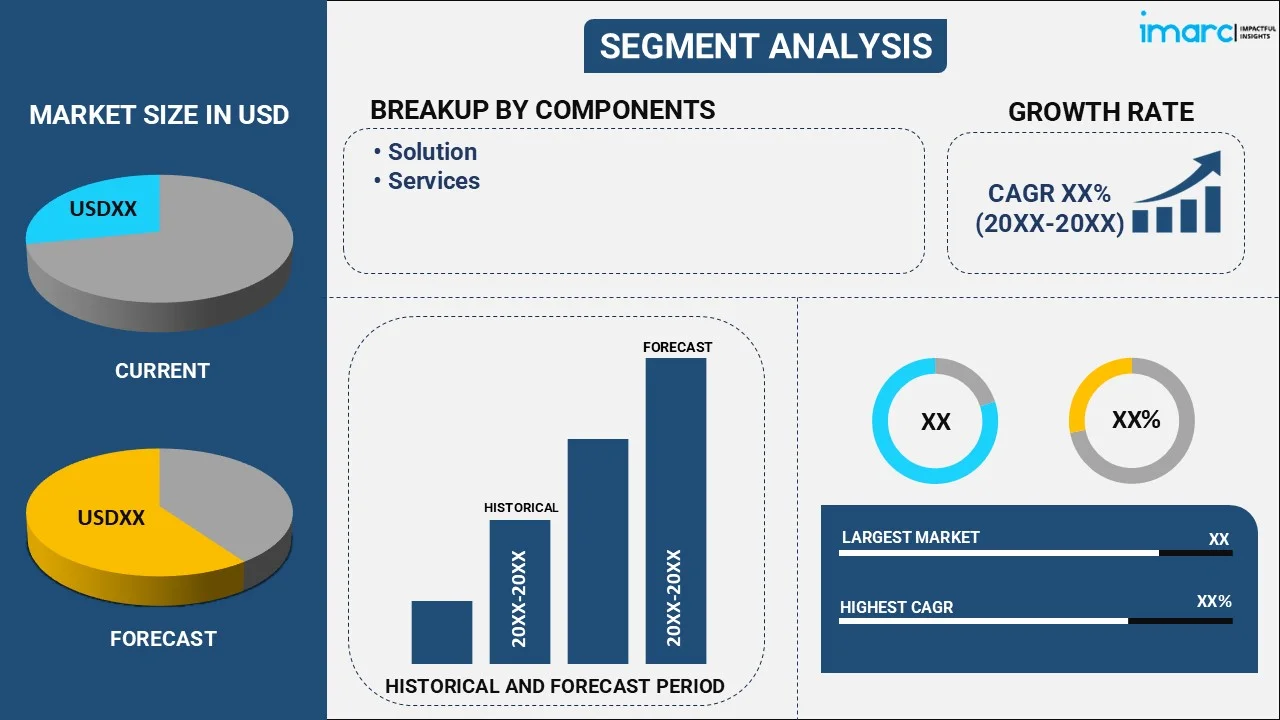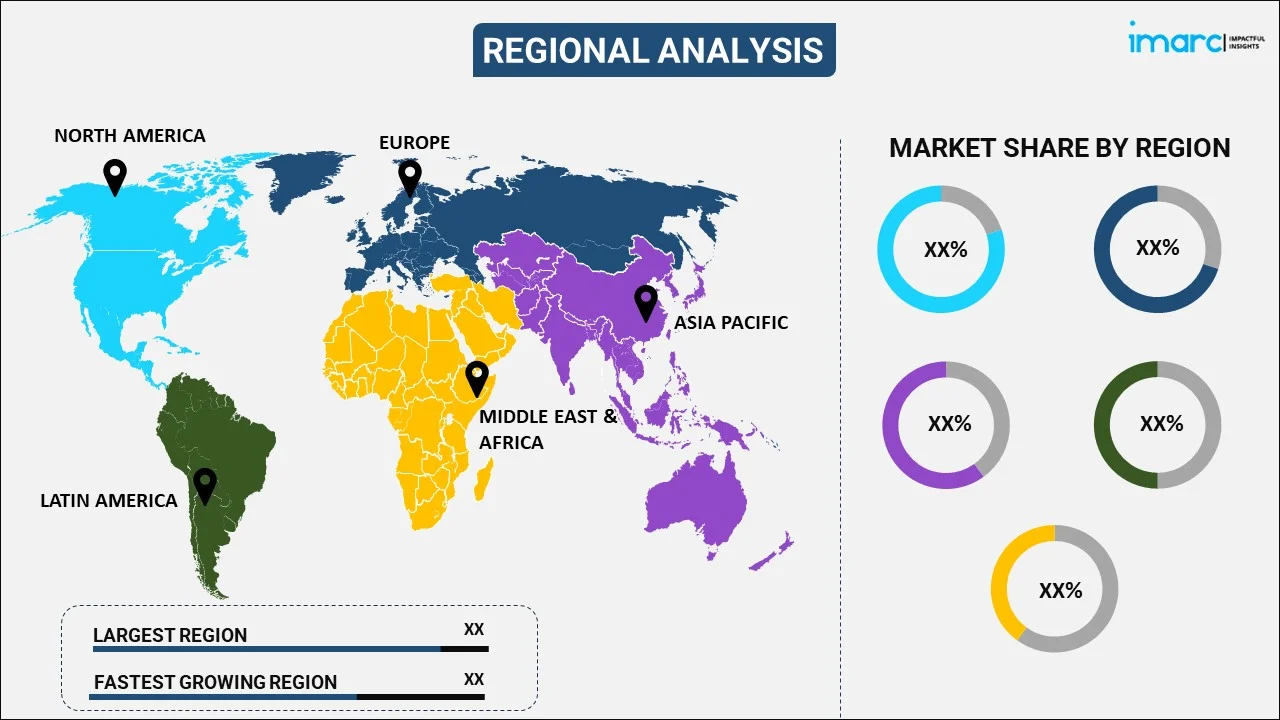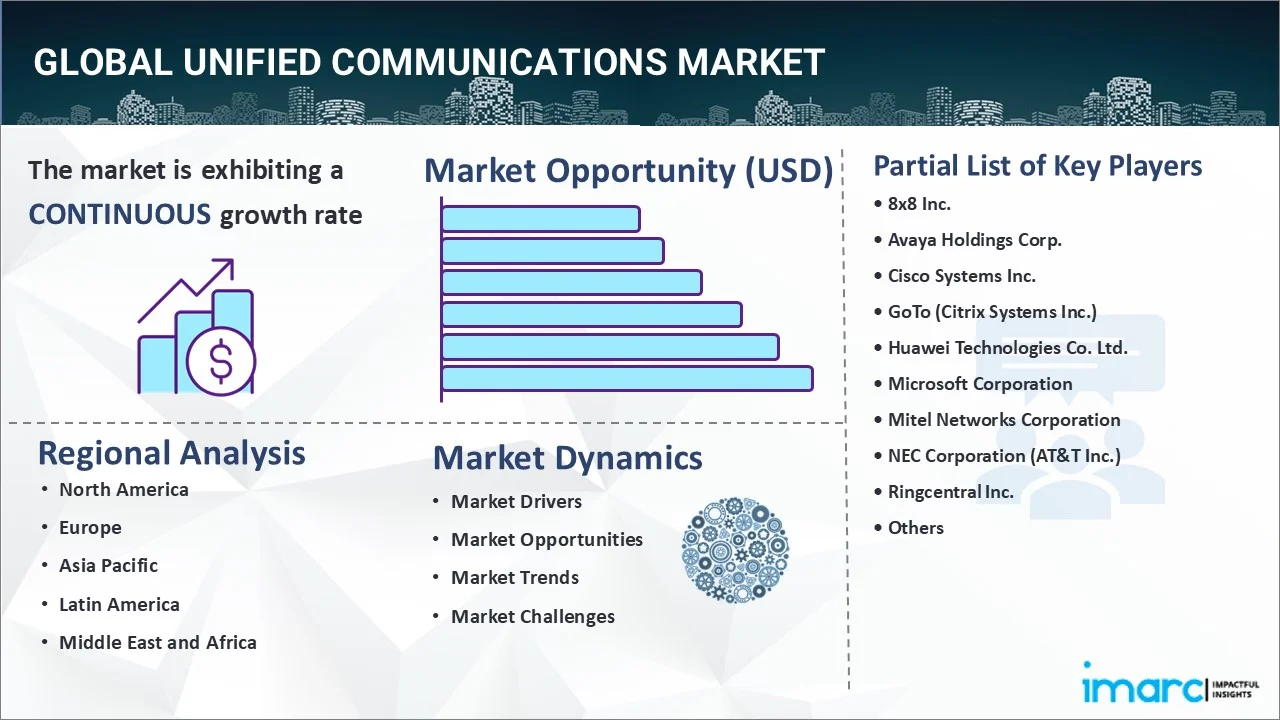
Unified Communications Market Report by Component (Solution, Services), Product (On-premises, Hosted), Organization Size (Small and Medium-sized Enterprises, Large Enterprises), End User (Enterprises, Education, Government, Healthcare, and Others), and Region 2025-2033
Unified Communications Market Size:
The global unified communications market size reached USD 146.2 Billion in 2024. Looking forward, IMARC Group expects the market to reach USD 530.5 Billion by 2033, exhibiting a growth rate (CAGR) of 14.63% during 2025-2033. The market is experiencing robust growth, driven by the increasing adoption of remote and hybrid work, rapid technological advancements, growing focus on customer experience, introduction of enhanced security features, rising importance of collaboration tools, and the heightened demand for unified mobility solutions.
|
Report Attribute
|
Key Statistics
|
|---|---|
|
Base Year
|
2024
|
|
Forecast Years
|
2025-2033
|
|
Historical Years
|
2019-2024
|
|
Market Size in 2024
|
USD 146.2 Billion |
|
Market Forecast in 2033
|
USD 530.5 Billion |
| Market Growth Rate 2025-2033 | 14.63% |
Unified Communications Market Analysis:
- Major Market Drivers: The ongoing shift toward remote and hybrid work models has positively impacted the unified communications market growth. Additionally, rapid innovations in artificial intelligence (AI), machine learning (ML), and cloud computing that enhance the capabilities of unified communication (UC) solutions, as well as the cost savings associated with these solutions, are acting as growth-inducing factors for the market expansion.
- Key Market Trends: The ongoing trend of connecting unified communication platforms with other business applications, like customer relationship management (CRM) and enterprise resource planning (ERP) systems, is driving the expansion of this market. Furthermore, the development of more advanced and user-friendly video features, as well as the incorporation of AI and ML technologies, are positively affecting the unified communication market share.
- Geographical Trends: North America is dominating this market owing to its advanced information technology (IT) infrastructure, rapid acceptance of new technologies, and large expenditures in cloud-based and AI-driven communication solutions. Other regions are also expanding due to increased digital transformation activities, a growing remote workforce, and significant expenditures in communication infrastructure.
- Competitive Landscape: Some of the major market players in the unified communications industry include 8x8 Inc., Avaya Holdings Corp., Cisco Systems Inc., GoTo (Citrix Systems Inc.), Huawei Technologies Co. Ltd., Microsoft Corporation, Mitel Networks Corporation, NEC Corporation (AT&T Inc.), Ringcentral Inc., Verizon Communications Inc., Vonage Holdings Corp. (Telefonaktiebolaget LM Ericsson), among many others.
- Challenges and Opportunities: Unified communication providers face several ongoing challenges in ensuring data security and compliance with industry-specific requirements. However, it is also creating an opportunity for those who can provide strong, compliance solutions. Furthermore, prospects for strategic collaborations and acquisitions among top organizations to improve market presence are creating growth opportunities.
Unified Communications Market Trends:
Increasing Adoption of Remote Work
Organizations are embracing remote and hybrid work models, which are creating the need for efficient communication tools, like unified communication (UC) solutions. According to an industry survey, more than 95% of Indian businesses are willing and will continue to implement the work-from-home (WFH) model. Moreover, as per a Gallup survey conducted in June 2022, 8 out of 10 employees are working hybrid or remote, with only 2 out of 10 working exclusively on-site. This data highlights the need for UC systems that enable real-time communication and collaboration among employees. These solutions combine voice, video, messaging, and collaboration tools into a single platform and help businesses maintain productivity and connectivity among geographically dispersed teams.
Rapid Advancements in Technology
Technological innovations are playing an important role in expanding the unified communications market share. The continuous advancements, leading to the development and refinement of communication technologies, such as Voice over Internet Protocol (VoIP), cloud computing, and artificial intelligence (AI) are some developments that have increased the demand for unified communication solutions. For instance, Verizon collaborated with Zoom to provide a new solution for unified communications. This collaboration gives users the access to join Zoom meetings from a Verizon Wireless phone or Verizon Voice-over-IP (VoIP), or just the audio portion of a Zoom meeting via Verizon VoIP, for no additional charge. Also, Acronym Solutions Inc. introduced a cloud-hosted unified communications as a service (UCaaS) solution that helps employees and customers to work together and aims to enhance business growth by delivering valuable insights to the customers present across the globe.
Growing Focus on Customer Experience
Organizations are majorly focusing on improving the customer experience, which is driving the adoption of this platform. Customer service is vital for companies as it increases brand loyalty and helps to build trust. As per industry research, 68% of consumers are willing to pay more for products and services from companies that provide excellent customer service. Furthermore, 93% of individuals are likely to make repeat purchases from businesses that provide exceptional customer service. In line with this, UC platforms are known for offering enterprises with the tools to conduct smooth and efficient customer interactions across numerous communication channels. By unifying these channels into a single interface, UC solutions enable customer service representatives to handle inquiries more effectively, reduce response times, and provide consistent service.
Unified Communications Market Segmentation:
IMARC Group provides an analysis of the key trends in each segment of the market, along with forecasts at the global, regional, and country levels for 2025-2033. Our report has categorized the market based on component, product, organization size, and end user.
Breakup by Component:

- Solution
- Instant and Unified Messaging
- Audio and Video Conferencing
- IP Telephony
- Others
- Services
- Professional Services
- Managed Services
Solution (instant and unified messaging) accounts for the majority of the market share
The report has provided a detailed breakup and analysis of the market based on the component. This includes solution (instant and unified messaging, audio and video conferencing, IP telephony, and others), and services (professional services and managed services). According to the report, solution (instant and unified messaging) represented the largest segment.
As per the unified communication market research report, instant and unified messaging solutions represented the largest segment due to their crucial role in facilitating real-time communication and collaboration across diverse business environments. Moreover, instant messaging provides quick, efficient, and direct communication, reducing the need for lengthy email exchanges and enabling swift decision-making processes. Additionally, unified messaging integrates various communication forms, such as voicemail, email, and short message service (SMS), into a single accessible platform, streamlining communication and improving accessibility. Along with this, the rising ability to access and manage multiple communication channels from a single interface, thereby making it an indispensable tool for modern enterprises, is catalyzing the market growth.
Breakup by Product:
- On-premises
- Hosted
On-premises hold the largest share of the industry
A detailed breakup and analysis of the market based on the product have also been provided in the report. This includes on-premises and hosted. According to the report, on-premises accounted for the largest market share.
According to the unified communication market analysis, on-premises solutions accounted for the largest market share. They are preferred by many organizations due to their robust control over data security, customization, and integration capabilities. These solutions involve deploying and maintaining UC infrastructure within the organization's data centers, providing greater control over sensitive communication data, and compliance with stringent industry-specific regulations. On-premises solutions offer extensive customization options, allowing businesses to tailor the system to their specific needs and integrate it seamlessly with existing on-site applications and systems.
Breakup by Organization Size:
- Small and Medium-sized Enterprises
- Large Enterprises
Large enterprises represent the leading market segment
The report has provided a detailed breakup and analysis of the market based on the organization size. This includes small and medium-sized enterprises and large enterprises. According to the report, large enterprises represented the largest segment.
Large enterprises are dominating this segment due to their complex communication needs, extensive workforce, and significant resources to invest in comprehensive UC solutions. These organizations require robust, scalable, and integrated communication platforms to facilitate seamless collaboration across multiple departments, locations, and time zones. In addition to this, they enable large enterprises to streamline their communication processes, improve operational efficiency, and enhance productivity by integrating voice, video, messaging, and collaboration tools into a single cohesive system, thereby boosting the unified communication market share.
Breakup by End User:
- Enterprises
- Education
- Government
- Healthcare
- Others
A detailed breakup and analysis of the market based on the end user have also been provided in the report. This includes enterprises, education, government, healthcare, and others.
Based on the unified communication market analysis, enterprises across various industries seek to enhance their communication and collaboration capabilities. They require robust and scalable UC solutions to manage internal and external communication effectively, streamline workflows, and boost productivity. Moreover, the integration of voice, video, messaging, and collaboration tools into a single platform allows enterprises to facilitate seamless communication among employees, regardless of their location, and improve customer engagement.
In the education sector, unified communications solutions play a crucial role in supporting remote learning, enhancing collaboration among students and faculty, and streamlining administrative processes. Educational institutions leverage UC platforms to facilitate virtual classrooms, conduct online lectures, and enable real-time communication and collaboration. These solutions offer features such as video conferencing, instant messaging, and document sharing that are essential for creating interactive and engaging learning environments.
The government segment requires reliable and secure communication solutions to support various functions, including public administration, emergency response, and inter-agency collaboration. Unified communications platforms provide government agencies with the tools needed to facilitate real-time communication, enhance coordination, and improve service delivery to citizens. Moreover, they offer features such as secure video conferencing, encrypted messaging, and integrated communication channels that are essential for ensuring data security and compliance with regulatory requirements.
In the healthcare sector, unified communications solutions are vital for improving patient care, enhancing collaboration among healthcare professionals, and streamlining administrative processes. They enable healthcare providers to conduct virtual consultations, facilitate real-time communication between doctors and patients, and support telehealth services. Moreover, these solutions offer Features such as secure messaging, video conferencing, and integration with electronic health records (EHR) systems that are important for maintaining patient confidentiality and ensuring compliance with healthcare regulations.
Breakup by Region:

- North America
- United States
- Canada
- Asia-Pacific
- China
- Japan
- India
- South Korea
- Australia
- Indonesia
- Others
- Europe
- Germany
- France
- United Kingdom
- Italy
- Spain
- Russia
- Others
- Latin America
- Brazil
- Mexico
- Others
- Middle East and Africa
North America leads the market, accounting for the largest unified communications market share
The report has also provided a comprehensive analysis of all the major regional markets, which include North America (the United States and Canada); Asia Pacific (China, Japan, India, South Korea, Australia, Indonesia, and others); Europe (Germany, France, the United Kingdom, Italy, Spain, Russia, and others); Latin America (Brazil, Mexico, and others); and the Middle East and Africa. According to the report, North America represents the largest regional market for unified communications.
According to the unified communications market research report, North America is dominating the market for unified communications due to the high adoption rate of advanced technologies, a well-established information technology (IT) infrastructure, and the presence of major UC solution providers. Moreover, the rapid adoption of innovative communication tools by businesses to enhance productivity, support remote work, and improve customer engagement is fueling the market growth. Additionally, the growing focus on digital transformation, coupled with significant investments in cloud-based solutions and artificial intelligence (AI), is boosting the market growth.
Competitive Landscape:
- The market research report has also provided a comprehensive analysis of the competitive landscape in the market. Detailed profiles of all major companies have also been provided. Some of the major market players in the unified communications industry include 8x8 Inc., Avaya Holdings Corp., Cisco Systems Inc., GoTo (Citrix Systems Inc.), Huawei Technologies Co. Ltd., Microsoft Corporation, Mitel Networks Corporation, NEC Corporation (AT&T Inc.), Ringcentral Inc., Verizon Communications Inc., Vonage Holdings Corp. (Telefonaktiebolaget LM Ericsson), etc.
(Please note that this is only a partial list of the key players, and the complete list is provided in the report.)
- The major market players are enhancing their platforms to stay competitive and meet evolving customer demands. They are focusing on integrating advanced technologies like artificial intelligence (AI), machine learning (ML), and cloud computing to offer more sophisticated and flexible UC solutions. Moreover, some leading companies are investing in research and development (R&D) to improve user experiences, enhance security features, and provide robust customer support to strengthen their market positions and address the diverse needs of businesses across various sectors. Additionally, they are focusing on sustainability initiatives and leveraging their platforms to support remote work and digital transformation trends.
Unified Communications Market News:
- In May 2023, NEC Corporation introduced UNIVERGE BLUE ARCHIVE, an innovative data retention solution for UNIVERGE BLUE CONNECT, a unified communications application. This new offering is designed to protect and support search and retrieval across different critical business communications channels, such as chat, phone call recordings, short message service (SMS), and voicemail.
- In January 2023, Verizon Communications Inc. partnered with Microsoft Corporation to deliver Teams Phone Mobile, the solution to provide Public Switched Telephone Network (PSTN) connectivity with Microsoft Teams and Phone System. This service integrates mobile devices with Microsoft Teams for easier calling and collaboration.
Unified Communications Market Report Scope:
| Report Features | Details |
|---|---|
| Base Year of the Analysis | 2024 |
| Historical Period | 2019-2024 |
| Forecast Period | 2025-2033 |
| Units | Billion USD |
| Scope of the Report | Exploration of Historical Trends and Market Outlook, Industry Catalysts and Challenges, Segment-Wise Historical and Future Market Assessment:
|
| Components Covered |
|
| Products Covered | On-premises, Hosted |
| Organization Sizes Covered | Small and Medium-sized Enterprises, Large Enterprises |
| End Users Covered | Enterprises, Education, Government, Healthcare, Others |
| Regions Covered | Asia Pacific, Europe, North America, Latin America, Middle East and Africa |
| Countries Covered | United States, Canada, Germany, France, United Kingdom, Italy, Spain, Russia, China, Japan, India, South Korea, Australia, Indonesia, Brazil, Mexico |
| Companies Covered | 8x8 Inc., Avaya Holdings Corp., Cisco Systems Inc., GoTo (Citrix Systems Inc.), Huawei Technologies Co. Ltd., Microsoft Corporation, Mitel Networks Corporation, NEC Corporation (AT&T Inc.), Ringcentral Inc., Verizon Communications Inc., Vonage Holdings Corp. (Telefonaktiebolaget LM Ericsson), etc. |
| Customization Scope | 10% Free Customization |
| Post-Sale Analyst Support | 10-12 Weeks |
| Delivery Format | PDF and Excel through Email (We can also provide the editable version of the report in PPT/Word format on special request) |
Key Benefits for Stakeholders:
- IMARC’s industry report offers a comprehensive quantitative analysis of various market segments, historical and current market trends, market forecasts, and dynamics of the unified communications market from 2019-2033.
- The research report provides the latest information on the market drivers, challenges, and opportunities in the global unified communications market.
- The study maps the leading, as well as the fastest-growing, regional markets. It further enables stakeholders to identify the key country-level markets within each region.
- Porter's five forces analysis assists stakeholders in assessing the impact of new entrants, competitive rivalry, supplier power, buyer power, and the threat of substitution. It helps stakeholders to analyze the level of competition within the unified communications industry and its attractiveness.
- The competitive landscape allows stakeholders to understand their competitive environment and provides insight into the current positions of key players in the market.
Key Questions Answered in This Report
The unified communications market was valued at USD 146.2 Billion in 2024.
IMARC estimates the unified communications market to exhibit a CAGR of 14.63% during 2025-2033.
The increasing demand for remote work and collaboration tools, advancements in cloud-based communication solutions, rising adoption of mobile devices and BYOD policies, growing need for seamless integration of communication platforms, and enhanced focus on improving business productivity and efficiency are the primary factors driving the unified communications market.
On a regional level, the market has been classified into North America, Asia Pacific, Europe, Latin America, and Middle East and Africa, wherein North America currently dominates the market.
Some of the major players in the unified communications market include 8x8 Inc., Avaya Holdings Corp., Cisco Systems Inc., GoTo (Citrix Systems Inc.), Huawei Technologies Co. Ltd., Microsoft Corporation, Mitel Networks Corporation, NEC Corporation (AT&T Inc.), Ringcentral Inc., Verizon Communications Inc., Vonage Holdings Corp. (Telefonaktiebolaget LM Ericsson), etc.
Need more help?
- Speak to our experienced analysts for insights on the current market scenarios.
- Include additional segments and countries to customize the report as per your requirement.
- Gain an unparalleled competitive advantage in your domain by understanding how to utilize the report and positively impacting your operations and revenue.
- For further assistance, please connect with our analysts.

 Inquire Before Buying
Inquire Before Buying
 Speak to an Analyst
Speak to an Analyst
 Request Brochure
Request Brochure
 Request Customization
Request Customization




.webp)




.webp)












